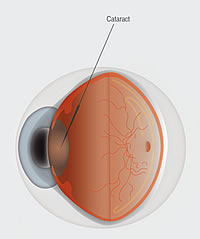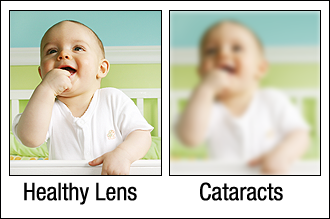 A cataract is a clouding of the eye's natural lens, which lies behind the iris and the pupil. The lens works much like a camera lens, focusing light onto the retina at the back of the eye. The lens also adjusts the eye's focus, letting us see things clearly both up close and far away. This lens is made of protein and water. The protein in the water is in a precise configuration that allows light to pass through and keeps the lens clear. As we age, this protein may begin to clump together and start to cloud some parts of the lens. When this occurs, it is called a cataract, and light is blocked from reaching the retina.
A cataract is a clouding of the eye's natural lens, which lies behind the iris and the pupil. The lens works much like a camera lens, focusing light onto the retina at the back of the eye. The lens also adjusts the eye's focus, letting us see things clearly both up close and far away. This lens is made of protein and water. The protein in the water is in a precise configuration that allows light to pass through and keeps the lens clear. As we age, this protein may begin to clump together and start to cloud some parts of the lens. When this occurs, it is called a cataract, and light is blocked from reaching the retina.
Cataracts begin slowly and may take years to develop. They cannot be prevented, and everyone will develop them if they live long enough. Cataracts usually develop in both eyes, although one may be further advanced than another. At first they are small and don't affect the vision much. However, with time cataracts may become large or thick, and they will need to be removed surgically. Cataract surgery is the primary therapeutic surgical procedure performed on Americans aged sixty ‐ five and older. Approximately 1.5 million cataract surgeries are done each year in the United States.
The main cause of cataracts is aging. By age fifty ‐ two to sixty ‐ four, there is a 50% chance that a person is developing a cataract although he or she won't notice a vision problem until about age sixty ‐ five. By age seventy ‐ five, nearly everyone has a cataract, and 50% of people have lost some vision. Many studies suggest that exposure to ultraviolet light is associated with cataract development, so eye care practitioners recommend wearing sunglasses to lessen exposure. Other studies show that diabetics and users of steroids, diuretics, or major tranquilizers seem to have a higher risk of developing cataracts earlier in their life. Smokers may also be at a greater risk of developing cataracts. Occasionally babies are born with cataracts. These are known as congenital cataracts . A traumatic cataract can form as a result of injury to the eye or inflammation of the eye.
The main symptom of a cataract is a decrease in vision. People with a developing cataract may have difficulty reading. Their sensitivity to light and glare may increase, causing difficulty driving at night and vision problems in bright sunlight. Colors may not be as vivid, and the cataract patient may have difficulty distinguishing colors. Lights may have a spoke ‐ like appearance. Cataract patients may experience distortion or ghost images in either eye. They may experience double or multiple vision. However, this symptom will usually go away as the cataract grows. Finally, Greenville cataract patients may find they need to have their glasses changed more frequently in order to see.

When Cataract symptoms begin to appear, treatment is usually unnecessary. Deciding when to have cataract surgery often is a subjective decision, based on how well you are able to see while engaging in routine activities. You might be able to drive, watch television, and work at a computer for quite a few years, even after you are first diagnosed with cataracts. Many people choose to improve their vision for as long as possible using new glasses, strong bifocals, magnification, appropriate lighting or other visual aids. Delaying surgery will not generally cause damage to the eyes. However, the doctor may decide to remove the cataract earlier than expected if it interferes with the treatment of another eye disease such as macular degeneration or diabetic retinopathy.
When cataracts begin to interfere with your normal daily activities, think about surgery to remove it. Many people consider poor vision an inevitable fact of aging, but cataract surgery is a relatively simple and painless procedure to regain vision. Cataract surgery is very successful in restoring vision and 9 out of 10 people who have cataract surgery regain vision somewhere between 20/20 and 20/40. It is actually the most frequently performed surgery in the U.S., with over 1.5 million surgeries done each year.
During surgery, the clouded lens is removed, and in most cases replaced with a clear, plastic intraocular lens (IOL). New IOLs are being developed all the time to make the surgery less complicated and the lenses more beneficial to patients.Presbyopia ‐ correcting IOLs potentially help you see at all distances, not just one. Another new type of IOL blocks both ultraviolet and blue light rays, which research indicates may damage the retina.
If a patient has cataracts in both eyes, your Greenville cataract surgeon will usually only operate on one eye at a time. The surgical procedure is uncomplicated and lasts only 15 to 30 minutes, with as much as 90 minutes needed for preparation and recovery. Typically there is a wait of a couple of weeks between surgeries, so that your first eye has the chance to heal and be evaluated in a follow ‐ up exam for any possible problems.
2014. All Rights Reserved. Medical website design by Glacial Multimedia ©
The material contained on this site is for informational purposes only and is not intended to be a substitute for professional medical advice, diagnosis, or treatment. Always seek the advice of your physician or other qualified health care provider.

